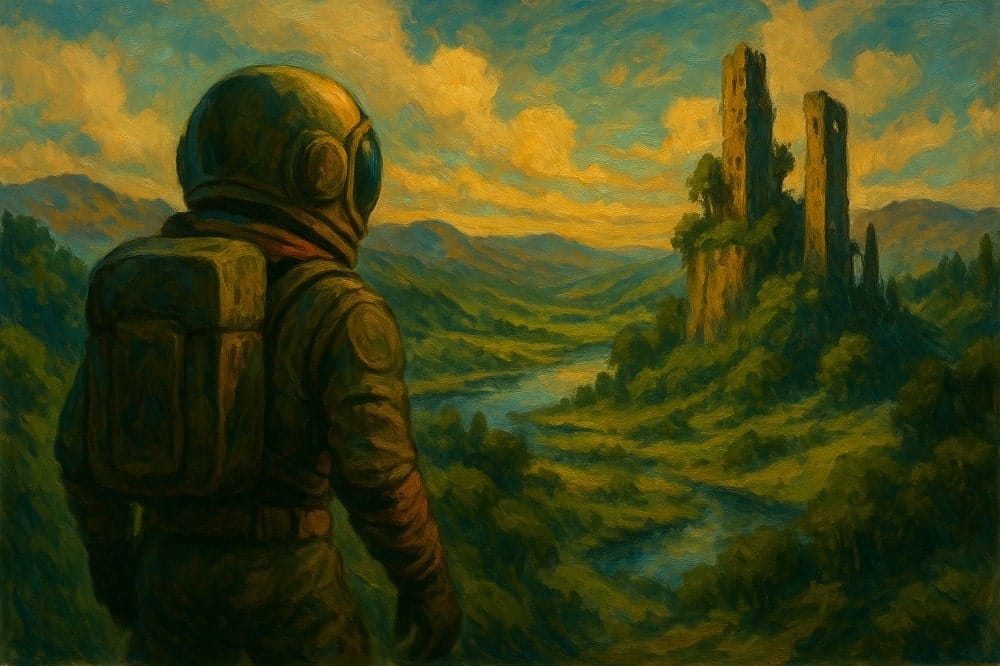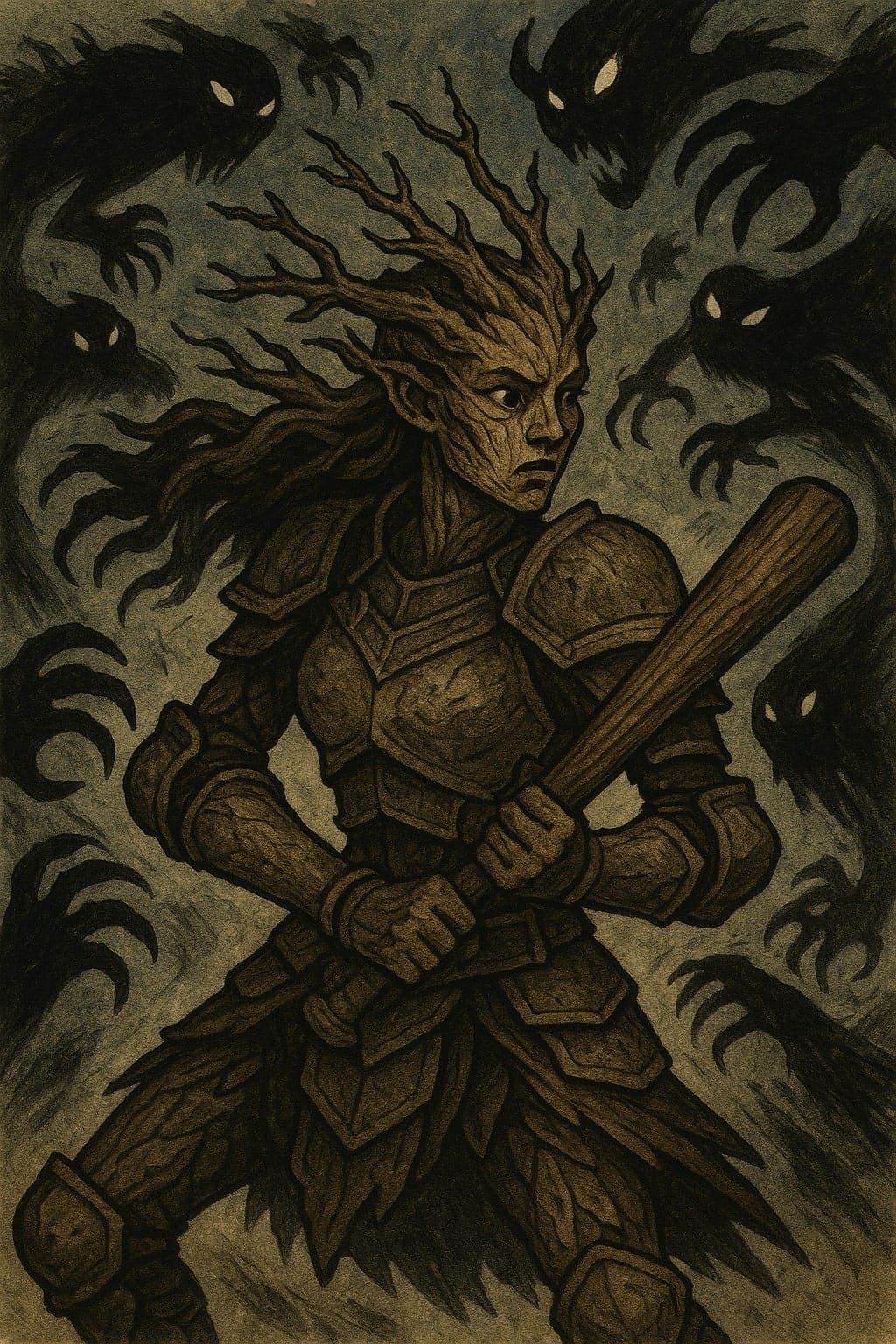Rules
If you are familiar with popular tabletop roleplaying games (TTRPGs) such as Dungeons & Dragons, Imaginarium RPG will immediately feel familiar. It uses a streamlined ruleset aimed at reducing onboarding and downtime for game masters and players. A new game requires far less setup than your typical TTRPG.
If you are new to TTRPGs, fear not. As a game master or player, you are not required to remember vast swaths of arcane rules in order to play. Imaginarium RPG is an intuitive and quick-to-learn experience.
Basics
Theater of the mind
Imaginarium RPG is designed to be played using something called theater of the mind. Although the game master (GM) may use visual aids such as maps or miniatures, the vast majority of play occurs within each participant's imagination. The GM narrates the story, plays all non-player characters, sets challenges, and adjudicates rules. They guide the game, describe the world, and react to players’ choices to move the story forward.

What comprises a gaming session
The basic flow of a session of Imaginarium RPG is:
In other words, the GM sets the scene. Players make decisions based upon the GM's description. The GM then presents a challenge or a story beat based upon those choices. This pattern repeats until a natural conclusion is reached in the session.
That may sound mechanical, but the process will unfold naturally as you play. Here's an example.
Three players, Jess the Human astronaut, Rk'gra the Kipling painter, and Leaves-in-Shadow the Sylvan baseball player, are exploring a forgotten valley. Their GM announces they've found a landmark:
Jess: I step into the clearing, approaching the crystal.
GM: As you move closer, the crystal glows an even brighter red, as if in warning.
Rk'gra: Let's break it!
Leaves-in-Shadow: Agreed. I raise my bat, charge forward, and try to smash it.
GM: That's a trivial Strength Check for you, Leaves, which you automatically succeed. As your bat shatters the crystal, shadowy figures appear from its remains. Prepare for a challenge!

For Game Masters
Challenges
Challenges are initiated at the GM's desire. The GM pulls a printed challenge card and place it on the table in front of his players.
There is no initiative. Players choose to go first, before their challenge, or second, after their challenge. Going second awards 🟨🟨 two golden dice for the duration of the Challenge to that player.
A player can take any amount of actions they see fit during their turn, so long as they have dice to spend. They draw from their dice pool plus any bonus dice from items or circumstances and spend them on abilities. If, instead, they have no remaining dice, they can take one of the two base actions at no cost. Likewise, the GM places his black dice on the challenges actions. He is not trying to "beat" his players, but play the Challenge as its logic dictates. The logic is elucidated on the Challenge card.
All participants - players and GM take their turns simultaneously. Players are encouraged to strategize together. Additionally, the GM runs the challenge at the same time, setting actions with his or her black dice. Once everyone is happy, the actions are resolved.
The Challenge ends when its victory condition is met. For many instances, this simply means reduce its hit points to zero. Some challenges with have different victory conditions, however.
Checks
Checks, Ability Checks, or Micro Challenges are any action the player takes outside of a Challenge proper where success is not a predetermined outcome. For example: climbing a steep cliffside. The GM makes a judgment call on the tasks difficulty and the nature of its difficulty. In this case, he or she might say that climbing the cliffside requires an excess of athleticism, and have the player roll a Strength check. Or, perhaps they merely need to identify a hidden staircase, so Mind is in order.
The player attempting the check rolls the number of dice corresponding to the type of check based on their stat attributes. If it is a Mind check, and they have 3 Mind, they rolls 🟦🟦🟦 three blue dice. In addition, the player may take any amount of dice they desire from their dice pool and "spend" it on the check. Be warned, however: it does not return to the dice pool until after they take a Short Rest, and therefore could leave them vulnerable during a Challenge.
The difficulty of the check is at the GM's discretion, but as a general guideline, an Easy check would require three resources to complete; Medium, six; Hard, nine; Impossible, twelve.
Range
Most abilities have a Range marker. Range is divided into four categories:
Next-To (N2), Short (S), Long (L), and Distant (D).
O1nly those within the Range can be targeted. For example, if an ability has a Long (L) Range, it can target anything at that range or below it, i.e. Long can target anything at Short or Next-To Finally, occasionally the word "Only" will appear next to a range. Long (Only), abbreviated to L(O), means it can only target at that specific range: Long.
In terms of visualization, Next-To means within arm's reach, Short means within ten yards, Long means anywhere between ten yards and few dozen yards, and Distant is anything between fifty to one hundred yards. For the majority of Challenges, Distant will not be used.
On Character sheets, Challenge cards, and Item cards, it is symbolized with the icon.
Imagination Tokens
Imagination tokens are a group resource assigned by the GM at the start of each day. Typically, two is the standard number, but the GM can assign more or less based on environmental conditions. Additionally, some Food items confer more tokens. Some confer less.
Tokens can be used outside of a Challenge to give players who have expended their rest an additional rest, and inside a Challenge to allow a player to add one of their character's stat attributes worth of dice to their pool. So, for example, if Jess the Astronaut, who has 4 Mind, spends an Imagination token during a Challenge during her turn choosing Mind, she immediately takes 🟦🟦🟦🟦 four blue dice, rolls them, and then can spend them.
As Imagination tokens are a group resource, it is helpful to get party buy-in before spending them.
Sleeping and Resting
At the end of the day, the party Sleeps. They must be safe. If at least one party member has a "Ration" item card, that card is spent and the party fully recovers. They regain Imagination tokens, their individual Short Rests, and re-roll their dice pools.
If the party is sleeping in a safe place within civilization, such as an inn or a friend or ally's house, they do not spend Ration cards and still make a full recovery. Typically, staying in an inn does incur a cost to players, however, in the form of cold, hard cash. The standard rate is ten dollars per player. Ration item cards are only required when players are roughing it – whether it be in a forest, on a mountain, in a desert, in a cave, in a dungeon, or in a particularly nasty part of town.
If the party Sleeps without Rations, they do not regain Imagination tokens, do not regain Short Rests, and re-roll only half of what they would normally roll for each stat attribute, rounded up.
Short Rests are individual and can be taken at any time the party is safe and outside of a challenge. Although in actual game-time, a few minutes are passing during Short Rests, mechanically a player simply announces "I am using a Short Rest", notes that they have used one of their Short Rests for the day, and promptly builds their dice pool once more, so as not to interrupt the flow of the Session.